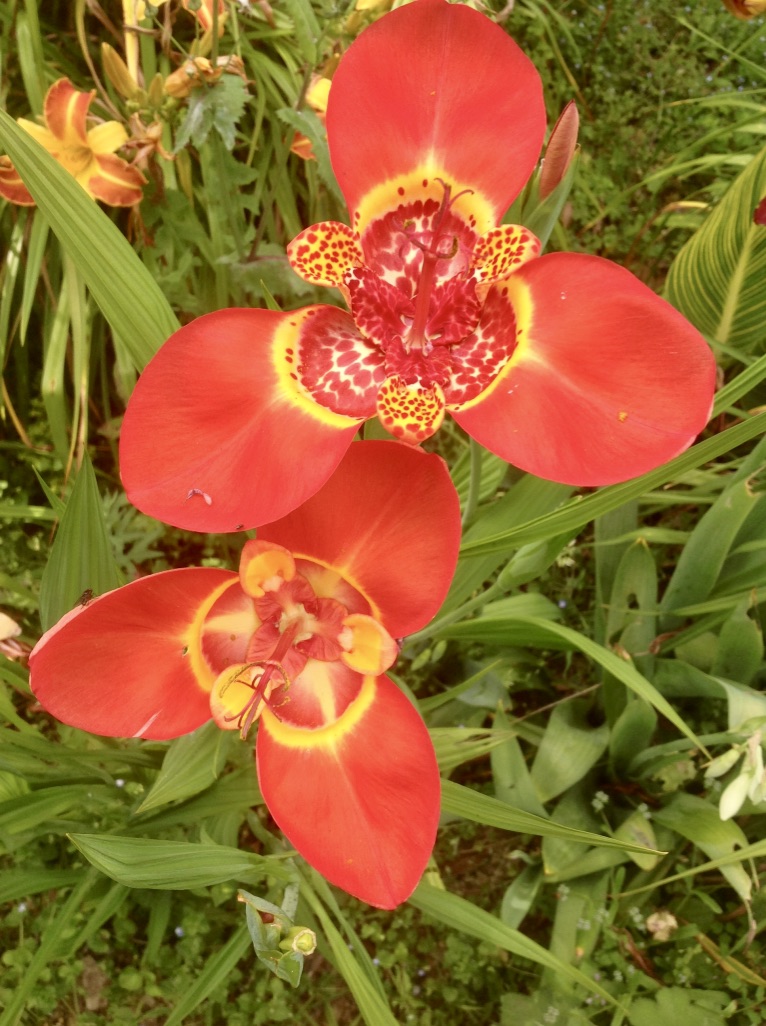Sustaining the summer show
Gardening is a four dimensional art form – we gardeners have to design our gardens to look beautiful, or at least interesting, over time – both over the year and over the years. In other words – we set ourselves up for failure!
May and June are wonderful months in the garden – the great rush of flowers and all the fresh new growth. It is so much harder to keep it up in July – often referred to as the ‘July dip’. This year it may prove harder than usual after the heat and drought of this May and June. Many flowers came and went in a flash – paeonies were over in one hot day, the bearded iris flowers went from stately crowns to shrivelled messes overnight. Most of the flowering shrubs have done their bit so it’s time for the herbaceous plants to take the strain. In the middle of a heat wave, I want to draw attention to some bulbous, tuberous and fleshy rooted plants that cope well with the summer heat.
Lilies and lily-ish plants
This is the time that members of the Liliaceae family and their relatives the Alstroemeriaceae, Amaryllidaceae, Iridaceae and the Asphodeliaceae really strut their stuff.

Alstroemeria (Peruvian Lilies) – the cut flowers beloved of garage forecourts – have been flowering right through June. They are popular as cut flowers because they last a good week in a vase and come in so many colours. They are also wonderful garden plants because they will keep sending up flowering stems all summer and autumn – some years I can pick some at ChristmasI There is one trick to repeat flowering and that is to pull out the spent flowers – yes – do not cut them off but yank them out of the ground. This rough treatment apparently stimulates the tubers to send up more stems.
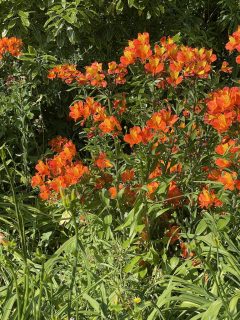
I grow deep plum Tessa, brilliant Orange King, golden Yellow King, brilliant Red Beauty and scarlet Mars in the ‘hot garden’. These are all tall varieties flowering at 1m plus so they need some space.
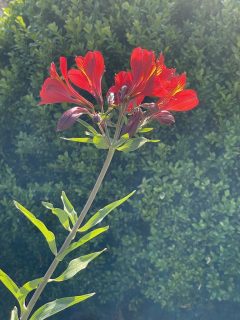
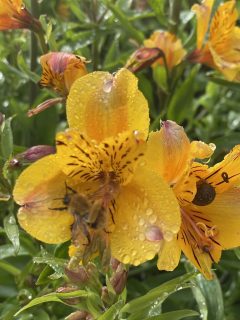
There are good varieties that flower at 50-80cm but I don’t like the dwarf ‘patio’ versions because the flowers are too large and clumpy for the plants. So I avoid any with Little Miss, Princess, Inticancha or Inca in their titles but these are almost the only ones now available in garden centres. You will have to go online to get the taller ones, H W Hyde and Hayloft still have some but Alstroemeria Select has gone over to the dark side and my old supplier Alstroemeria Direct has disappeared. Hunt them down now and list them for ordering next spring. Be warned, they can take a year or two to settle down and achieve full vigour but they are so so worth it.

Hemerocallis – the Daylilies are also stalwarts of the July to August border. Each flower only lasts a day but they keep coming for a good month Again, you need to choose carefully, I’ve made several bad buys before settling on a few that work for me. I don’t like doubles – they lose the elegance of the single. I don’t like the ones with splotches of another colour in the centre or the ones with fat and frilly petals, many of which have very silly names – but each to his own. I do like the ones with elegant long flowers and where the flowers stand well above the leaves like that old cultivar, bright red Stafford. I also like the small species Hemerocallis lilioasphodelus – small, scented, pure yellow and the first to flower and Corky – another small yellow with light foliage but with dark rust backs to the petals. Another favourite – in the fashionable colour of putty pinkish/apricotish/brownish tones – is Pink Damask. It sits happily at the feet of cream and soft apricot roses. A dizzying range of cultivars can be bought from Strictly Daylilies and a more select 57 varieties from Claire Austin.
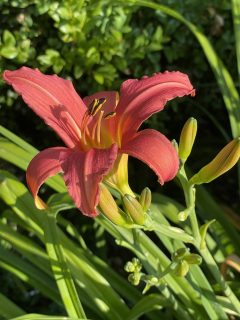
Another benefit of Daylilies is that they attract snails and slugs to hide in their leaves – if you groom the plants daily, like a chimpanzee looking for parasites, you can do serious damage to your snail population.
Tigridias – (tiger lilies) are bulbous plants that belong to the Iris family. The only ones easily available are cultivars of Tigridia pavonia in a range of colours – white, cream ,yellow, pink and red. They are often sold in mixed colours which I think are a bit too jazzy but single colours can be bought from Jaques Amand and J Parkers Dutch Bulbs.
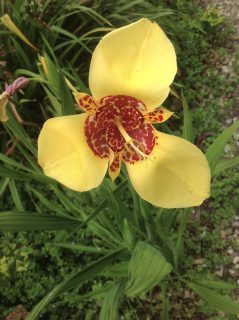
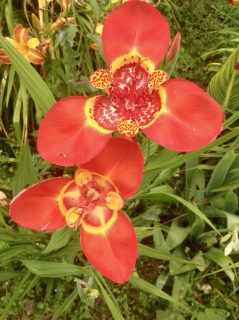
Eremurus – the Fox Tail lilies are members of the Asphodel family. Wonderful columns of hundreds of small flowers open progressively up the long inflorescences. They come in several colours and heights. Clear yellow E. stenophyllus flowers at 1-1.5m; E.x isabellinus Cleopatra has long spikes of soft orange at 1.5m but the really big boys are E. himalaicus, white flowered at 2-2.5m and E.robustus, peachy pink at 2.5-3m! Despite their height, the cluster of leaves at the base takes up very little room so they can be fitted in to even small borders to provide some high drama. The stems are tough but coastal winds may be too much for them. They need dry, well drained soil, don’t seem to have any pests other than slugs and snails when emerging and are loved by bees. Again, the dutch bulb companies Parkers, Amand and Farmer Gracy are good value.
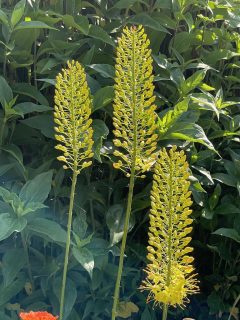
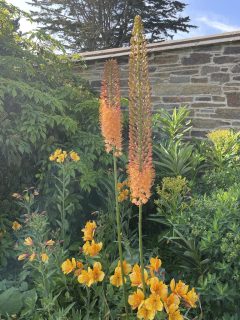
Agapanthus commonly known as African lilies are members of the Amarillis family. Everyone in Cornwall knows these, they are everywhere in gardens and have frequently escaped out of gardens. They have a typical ball of flowers on strong stems and have been bred and cross-bred to produce a huge range of sizes and colours in the white/blue/purple range. Agapanthus africanus cultivars are generally larger and evergreen whereas A. praecox and A.campanulatus offspring are smaller, deciduous and more cold tolerant. Agapanthus inapertus is deciduous with deep purple hanging flowers. There are too many cultivars to mention but don’t settle for the ordinary – it is worth exploring the range. In Cornwall, Lower Kennedy Nurseries usually has good varieties and online, Beth Chatto has a good range all at £11.50 for 2 litre plants and Fairweathers have a great selection at £17 for a 2.5 litre pot. The RHS Plant of the Year 2023 was Black Jack – a dark purple agapanthus with rounded inflorescences of up to 100 florets. It looks stunning but at £14.99 – £18.00 for a 9cm pot – its probably worth waiting a year or two for the price to come down.
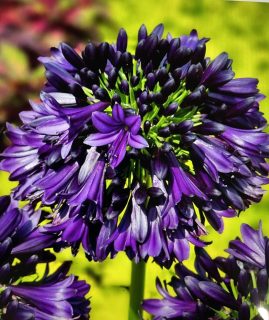
True lilies
How can you have a garden without true lilies? They are so exotic looking but they can also blend so easily into mixed plantings. There are so many types and cultivars so i’ll just mention a few favourites. I have several Turks Cap lilies in the Hot Garden and I love this form. I have some enormous yellow lilies emerging out of a mass of native field poppy. J Parkers Dutch bulbs sent me these as Lilium leichtlinii and they are very dramatic – a 1.5m tower of hanging yellow lily flowers with lovely brown spots – but they look like leichtlinii on steroids. True L. leichtlinii are taller (2m), have narrower leaves and dark stems and more elegant hanging flowers. I have some of the true species and far prefer them but cannot bring myself to discard these glorious interlopers.
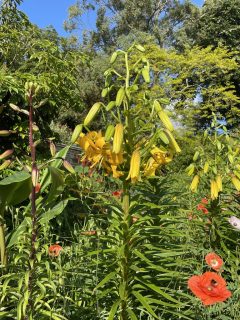
Another Turks Cap that I’ve planted a lot of is Red Life. It grows over 1m with a lovely open inflorescence of hanging orange red flowers well dotted with deep burgundy spots. Both of these re-appear reliably every year and bulk up slowly. Plant them in groups of 3 or 5 giving them enough space to expand their flowers without colliding.
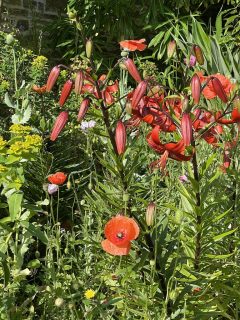
In the rose border, I plant Lilium regale. Here I find they fade out after a few years but they are worth replacing regularly. The have clusters of forward facing trumpets, white with yellow centres and soft pink stripes on the back of the petals. They compliment peach, cream and soft yellow roses and, just when the roses are having a rest, they open to send an enormous scent cloud into the air. There is also a white version which lacks the pink but still has yellow throats. Several white lilies work well with roses. Lilium Casa Blanca – is pure white, an oriental lily with large open recurved petals and very fragrant. Lilium Everest is also an oriental type, white with deep pink spots, scented and tall (1.2m).
Plant lilies just the depth of the bulb, they are happy in well drained soil but will need to be fed and watered in the growing season to ensure re-flowering. I buy lilies almost exclusively from J Parkers Wholesale – they sometimes make mistakes but I forgive them because they are so cheap at £7-8 for 10.

Keeping control
The roses are glorious now but, stressed by the hosepipe ban, are not looking like they’ll keep giving in July. I am being punished for hubris. In my June article, I claimed that I could keep blackspot off my roses by feeding. Six weeks of drought has been too big a stress and I do have some fungal damage this year. The best way to help them is to use a liquid feed and reduce the crown by aggressive dead heading. Don’t just snip off the flower heads – use the dead heading to do a summer prune – cut back to a strong bud 20- 30 cm below the flower cluster.
Its not just the roses that need a good cut back. Now is the time to cut over many of the spring flowering shrubs. Many shrubs get woody and leggy after only a few years if left to themselves: Cistus (rock roses), evergreen Ceanothus, Callistemon (bottle brushes), Lupinus arboreus (tree lupins), the shrubby Phlomis species, Prostanthera species (Australian mintbushes), rosemary and lavenders all need cutting over straight after flowering to keep them tight and leafy. I usually cut back a bit beyond the flowering stems but not into the woody stems for most of these. Even so, many of these shrubs have a short lifetime of looking good and need replacing after 4-8 years so I take replacement cuttings in late summer – when I remember.

